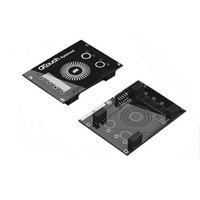ATAVRQTOUCHX Atmel, ATAVRQTOUCHX Datasheet - Page 53

ATAVRQTOUCHX
Manufacturer Part Number
ATAVRQTOUCHX
Description
BOARD EVAL CAPACITIVE TOUCH
Manufacturer
Atmel
Series
QTouch™r
Specifications of ATAVRQTOUCHX
Sensor Type
Touch, Capacitive
Sensing Range
1 Slider, 1 Wheel, 2 Buttons
Interface
USB
Voltage - Supply
5V, USB
Embedded
Yes, MCU, 8-Bit
Utilized Ic / Part
AT90USB1287, ATxmega128A1
Silicon Manufacturer
Atmel
Silicon Family Name
ATxmega
Kit Contents
Board
Svhc
No SVHC (15-Dec-2010)
Core Architecture
AVR
Core Sub-architecture
AVR19
Kit Features
One Slider, One Wheel And 2
Rohs Compliant
Yes
Lead Free Status / RoHS Status
Lead free / RoHS Compliant
Sensitivity
-
Lead Free Status / Rohs Status
Lead free / RoHS Compliant
Available stocks
Company
Part Number
Manufacturer
Quantity
Price
Company:
Part Number:
ATAVRQTOUCHX
Manufacturer:
Atmel
Quantity:
135
The host application must provide the current time to the library. This information is passed to the
library as an argument to the function qt_measure_sensors()”. This is used for time-based library
operations such as drift compensation.
5.6.10.3 Integrating QMatrix acquisition method libraries in your application
Based on the application design needs, the user needs to select the right library variant and the
configuration to be used along with the variant. This section illustrates the steps required to select
the right QMatrix acquisition method library variant and configuration for your application. QMatrix
acquisition method library Variants are offered for IAR and AVR-GCC tool chains. First step is to
select the compiler tool chain for which the libraries are required. The list of supported compiler
tool chains can be found in section 5.7.2.2
There are specific library variants distributed for each microcontroller. For your design, you would
need the following information to select the correct library variant
Follow the steps listed below to arrive at the right library variant
a. Device to be used for the design
b. The number of touch sensing channels needed by the application – Then identify the
c. Number of X lines to be used in the design
d. Number of Y lines to be used in the design
e. Do you need support for Rotors and/or Sliders in your design
f.
1) Select the device from the list of supported devices listed in 5.7.2.4.1
2) Select the right library variant for the device selected from the selection guide available
3) Define the constants and symbol names required
The 16 bit timer in each device has been used for performing touch measurements
periodically. The datasheet for all the devices have to be checked to ensure that the
correct timer peripheral and its registers are used (file: main.c).
The interrupt vector macro may also change from device to device and this needs to be
verified in the datasheet for the device used.
Check if the timer is configured correctly to support the measurement period needed (e.g.
25msec or 50 msec).
The sample applications for the evaluation kits and supported devices illustrate the
proper initialization sequence and usage of the timer resources (file: main.c). Please use
this as a reference for your application design.
Maximum number of channels required for the design that are supported by the library.
Which compiler platform you intend to use to integrate the libraries – IAR or AVR -GCC
in
C:\ Program Files\Atmel\Atmel_QTouch_Libaries_4.x\Library_Selection_Guide.xls
Each variant supports
a. The ports on which your design permits to have the X lines
b. The X lines can be spread on a maximum of three ports, the more ports used the
a. The port-pins ports on which your design permits to have the Y lines
a. If yes, how many rotors/sliders would be needed?
b. Based on a) above, identify the maximum number of rotors sliders that the library
a. a specific number of channels,
b. Supports a specific configuration of X x Y matrix pins ( eg 4 x 2 for 4 - X pins & 2
c. has support for Rotor / Slider ( either supported or not )
d. support is available for IAR and/or GCC compiler tool chain
e. support for specific number of rotors sliders.
a. The next step is to define certain constants and symbols required in the host
more is the code memory requirement by the library.
supports
- Y pins )
application files where the touch API is going to be used. These values are
derived from the parameters defined in step 2 for your application
53















